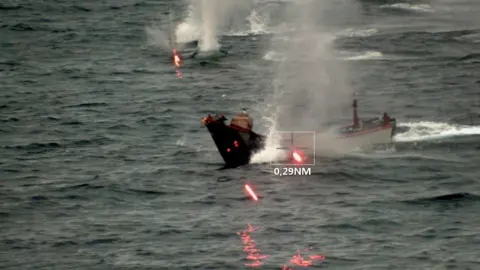The 25 crew members of a Greek-owned and flagged oil tanker have been rescued by a European warship in the Red Sea after multiple attacks on Wednesday.
The Sounion, which is carrying 150,000 tonnes of crude oil, was first hit by gunfire from two small boats which approached it 77 nautical miles (143km) west of the Yemeni port of Hudaydah, the UK Maritime Trade Operations (UKMTO) office said.
Later, the ship was struck by three unidentified projectiles, which sparked a fire and left it without engine power, it added.
No group has claimed responsibility for the attack, but US officials blamed Yemen-based Houthis. The group has launched multiple attacks on shipping in the Red Sea.
On Thursday, EU's Red Sea naval mission said one of its ships had destroyed an unmanned surface vessel (USV) as it rescued all of those on board and transported them to Djibouti.
“The MV Sounion now represents a navigational and environmental hazard,” EUNAVFOR warned.
“It is essential that everyone in the area exercises caution and refrains from any actions that could lead to a deterioration of the current situation.”
The Sounion’s operator, Delta Tankers, said the fire onboard was extinguished before it was abandoned by the crew and that it was working on a plan to move the vessel to a safer destination for further checks and repairs.
The vessel was initially adrift after losing engine power but is now at anchor.
 EPA
EPANo group has yet said it was behind the attacks, which Greece’s minister of maritime affairs condemned as a flagrant violation of international law.
However, Yemen’s Iran-backed Houthi movement has repeatedly targeted commercial shipping in the Red Sea and Gulf of Aden since November.
The Houthis say they are acting in support of the Palestinians in the war between Israel and Hamas in the Gaza Strip. They have claimed - often falsely - that they are targeting ships only linked to Israel, the US or the UK.
They have not been deterred by the deployment of Western warships to protect merchant vessels or by US and British air strikes on territory they control in north-western Yemen. Israel also bombed Hudaydah’s port last month in retaliation for a deadly drone strike on Tel Aviv.
Deputy Pentagon Press Secretary Sabrina Singh directly blamed the group for the attack, and raised doubts about what had been accomplished with it.
Ms Singh added she was "not exactly sure how [the attack] helps anyone in Gaza". She pointed out the ship was sailing under a Greek flag, with a crew of Russian and Filipino sailors.
The Sounion, which is a 274m-long and 50m-wide “Suezmax” tanker, was carrying crude oil from the Iraqi port of Basra when it was attacked.
EUNAVFOR said the tanker had not asked for protection from the mission beforehand, but that a ship had been dispatched to rescue the crew following a request from the master.
Regarding the potential environmental impact of the attack, Ms Singh said US officials would consult with the ship's operators, but said she was not "aware of anything else that we're doing at this moment".
Also on Wednesday, the Panama-flagged cargo vessel SW North Wind I reported three explosions in the water nearby as it sailed through the Gulf of Aden, the UKMTO said.
It added that the crew was safe following the incidents, which happened 57 nautical miles south of the Yemeni city of Aden, and the vessel was proceeding to the next port of call.
In June, the Liberian-flagged, Greek-owned cargo ship Tutor sank and one crew member was killed after the Houthis attacked it with a USV in the Red Sea.

Comments
Post a Comment